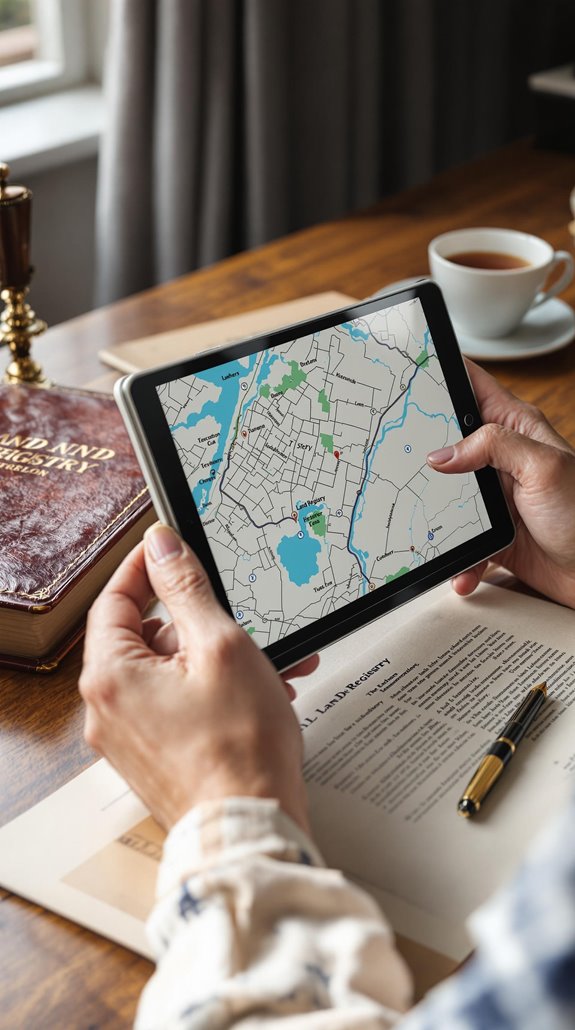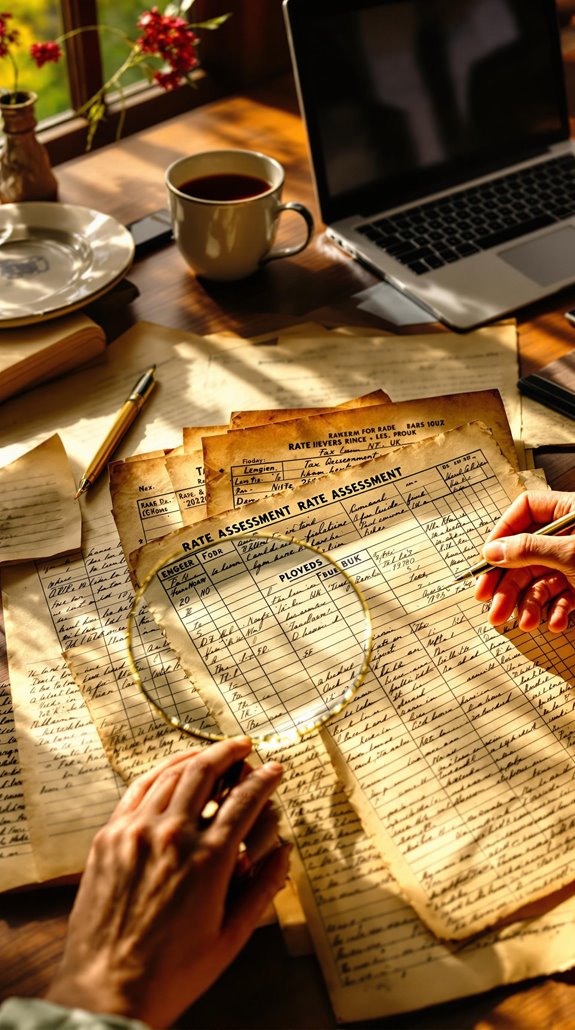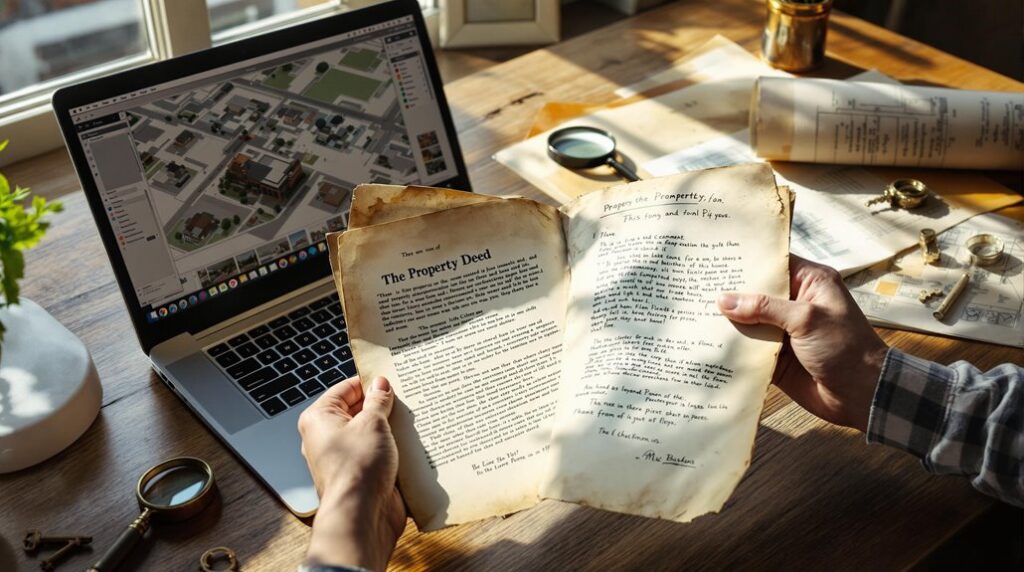I’ve learned that purchasing a property without understanding its history can lead to costly surprises down the line. Whether you’re dealing with boundary disputes, hidden structural issues, or unexpected legal complications, the past always finds a way to surface. That’s why I always recommend conducting thorough historical research before you commit to any purchase. The process isn’t complicated, but it requires knowing exactly where to look and what questions to ask.
Key Takeaways
- Start with HM Land Registry to obtain the full title register for comprehensive ownership history and legal details.
- Use census records from 1841-1921 and electoral registers to identify previous occupants and verify property usage patterns.
- Access Valuation Office Survey records and historical Ordnance Survey maps to understand physical changes and property boundaries.
- Cross-reference multiple sources including planning applications, Building Control certificates, and newspaper archives for complete verification.
- Validate seller identity through Land Registry’s Online Owner Verification service and confirm mortgage status accuracy.
Building Your Research Framework and Timeline
Before diving into archives and record offices, you’ll need to establish a systematic approach that prevents you from getting lost in centuries of documentation. I recommend creating a chronological ownership list, working backwards from current occupants to trace each previous owner. This becomes your research backbone.
Start by compiling addresses of all relevant local archives and record offices in your area. Define your property’s boundaries using historical maps and plans—you’d be surprised how often boundaries have shifted over time. Identify key historical periods that likely impacted your property’s architectural features, whether it’s Victorian expansion or post-war reconstruction. Consider checking with local higher education providers who often serve as anchor institutions and may have collected historical documentation about community development.
Set realistic timelines for each research phase. I typically allocate two weeks per century, but adjust based on your property’s complexity and available records.
Gathering Initial Information From Local Sources
Once you’ve established your research framework, local archives and record offices become your primary hunting grounds for concrete property evidence. I’ll start by searching their online catalogues using your property’s address and any historical owner names you’ve discovered. These repositories hold building plans, maps, and electoral registers spanning back to the mid-19th century.
County record offices offer particular treasures – valuation books from 1910 Inland Revenue surveys and tithe apportionments showing land use after 1836. Don’t overlook the archivists themselves; they’re invaluable for locating estate papers, manorial records, and solicitors’ deed collections that might reference your property.
Rate books from the mid-19th century onward provide exact addresses and occupier details, while parish chest materials often contain surprising property connections through overseers’ accounts and settlement records. Remember that many historical residents were renters rather than owners, so tracking occupancy patterns can reveal the full story of who actually lived in your property.
Accessing Land Registry and Title Deeds

While local archives provide historical context, HM Land Registry offers the most extensive modern property records for England and Wales. I’ll show you how to access these essential documents efficiently.
Start with the free title summary, which reveals tenure type, current owner, last sale price, and basic restrictions. For deeper insights, order the full title register (£7) containing complete ownership history, mortgage details, and legal covenants affecting the property. The title plan displays approximate boundaries and location context.
Use HM Land Registry’s “Search for land and property information” service for immediate digital access. Remember, records only cover sales since 1993, so older properties may have gaps. If you can’t locate your property, request an index map search for non-standard addresses. When you need documents for legal purposes, ensure you order official copies rather than standard online versions, as these provide legally valid proof of ownership.
Using Census Records and Electoral Registers
After establishing property ownership through Land Registry records, census data reveals who actually lived in your property and how they used it. I’ll guide you through accessing these invaluable records that document every decade from 1841 to 1921.
Start with Findmypast’s address search feature—it’s the only platform offering thorough UK census searches by specific address. You’ll discover occupants’ names, ages, occupations, and birthplaces, plus whether your property served residential or commercial purposes.
For gaps between census years, I recommend checking electoral registers at local archives. These annual records track voting residents and reveal ownership changes, especially useful for the 1921-1939 period.
Cross-reference these findings with your Land Registry research to build a complete occupancy timeline and understand your property’s evolving role. Keep in mind that online transcriptions may contain errors due to transcriber guesswork, so verify important details against original records when possible.
Exploring Historical Tax and Rate Assessment Records

Tax and rate assessment records provide another valuable layer of property history research, particularly through the thorough Valuation Office Survey conducted between 1910-1915. I’ll guide you through accessing these extensive records that cover the entire UK.
The Valuation Office Survey, often called the “Domesday Survey,” contains detailed information about property values, ownership, occupancy, and physical characteristics. You’ll find names of owners and tenants, rental details, room counts, and property usage classifications.
To access these records, you’ll need to use index maps to locate your property, then reference the corresponding field book entries. The National Archives holds original records for England and Wales, while local archives often have working copies that are easier to navigate and research. When researching property transactions, be aware that methodology changes have been implemented in recent years to improve the accuracy of historical property data and transaction counts.
Examining Maps, Plans and Survey Documents
Once you’ve gathered ownership records and tax assessments, maps and survey documents become your most powerful tools for understanding a property’s physical evolution over time. I’ll start with Ordnance Survey historical maps, which you can purchase directly from OS. These show ground features at survey time and reveal how your property’s surroundings have changed.
The National Archives holds Valuation Office Survey records from 1910-1915, featuring annotated OS maps with property boundaries and assessment numbers. Field books cross-referenced to these maps contain detailed property descriptions, ownership details, and land use information. The survey was organized into 118 valuation districts across England and Wales, each managed by a district valuer who oversaw multiple income tax parishes.
For modern properties, I’ll access HM Land Registry title plans through their portal. These show current boundaries and I can request historical versions by specifying date ranges and title numbers.
Searching Photographic Archives and Newspaper Records

Visual evidence through photographs and newspaper records reveals details about your property that maps and documents can’t capture. I’ll start with Historic England’s archive, which contains extensive building photographs accessible through their online catalog. Their Images of England project specifically documents listed buildings, while the Missing Pieces Project welcomes public contributions.
Your local record office holds archived newspapers and historical photographs, often including unique sketches or postcards. These provide contextual evidence about previous occupants and property events. I’d recommend checking newspaper archives for sale advertisements, renovation reports, and neighborhood developments through services like the British Newspaper Archive.
Online platforms like Britain From Above offer aerial photographs showing property evolution over time. County archives and university libraries maintain specialized collections, while community social media groups share crowdsourced neighborhood photos. Additionally, local archives serve as primary sources for house history research and may contain photographic collections alongside their maps, electoral registers, and estate papers.
Investigating Specialized Property Records
While photographs and newspapers show what happened to a property, specialized records reveal the legal framework that governs it. I’ll guide you through accessing the Land Registry‘s title registers, which contain ownership history, sale prices, and mortgage status for your target property.
You’ll need the title number to retrieve these records through the Land Registry portal. The title register will show restrictive covenants that might limit how you can use the property, plus any easements like rights of way that affect access. Pay attention to the title classification—Title Absolute offers the strongest ownership proof, while Possessory Title suggests ownership through occupation rather than formal deeds. Understanding whether the property has freehold or leasehold status is crucial, as this affects the complexity of the property transfer process and may lead to hidden costs such as ground rent and service charges.
Don’t forget to purchase the full register rather than just the summary, as you’ll need complete covenant details for proper due diligence.
Cross-Referencing Sources and Verifying Findings

Because property records often contain gaps, inconsistencies, and outdated information, you’ll need to cross-reference multiple sources to build an accurate picture of your target property’s history. I recommend starting with HM Land Registry data, then validating ownership details against electoral rolls and census records. Cross-reference planning applications with visible property modifications using aerial imagery comparisons. Verify structural changes through Building Control completion certificates and authenticate flood risk data with Environmental Agency maps. Not having a Building Regulations Completion Certificate can complicate your research and future property transactions, so it’s wise to understand this aspect.
When discrepancies arise, use specialist channels like National Archives tithe maps for boundary disputes or Coal Authority reports for mineral rights. I always validate seller identity through Land Registry’s Online Owner Verification service and confirm mortgage status via lender statements. The British Newspaper Archive provides digitized articles that can reveal historical incidents, sales, or notable events connected to your property. This multi-source approach guarantees you’re making informed decisions based on thorough, verified information.
Conclusion
I’ve shown you how to systematically research a property’s history using multiple sources—from Land Registry records to historical maps and census data. Don’t skip any steps in this process. Cross-reference everything you find to verify accuracy and identify potential red flags. This thorough approach will reveal hidden issues before you commit to purchase, potentially saving you thousands in unexpected costs and legal complications down the line.
References
- https://www.herefordshire.gov.uk/herefordshire-archive-records-centre/researching-house-history
- https://www.findmypast.co.uk/blog/help/the-history-of-your-house
- https://historicengland.org.uk/advice/your-home/your-homes-history/how-to-find-out/history-of-house/
- https://www.nationalarchives.gov.uk/help-with-your-research/research-guides/houses/
- https://historicengland.org.uk/advice/your-home/your-homes-history/how-to-find-out/
- https://kef.ac.uk/about
- https://www.shoulers.co.uk/articles/period-property-a-rough-guide-to-timelines
- https://heritage.warwickshire.gov.uk/talks-research-guides/house-history-sources/1
- https://www.thelondonarchives.org/your-research/research-guides/house-history
- https://historicengland.org.uk/advice/your-home/your-homes-history/further-resources/

